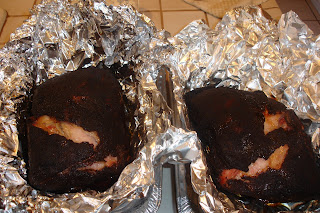
Wikepedia defines Bibambap as ".....a popular Korean dish. The word literally means "mixed rice" or "mixed meal". (It is also sometimes spelled "bibimba" or "bibimbop").
Bibimbap is served as a bowl of warm white rice topped with namul (sautéed and seasoned vegetables), beef, a fried egg, and gochujang (chile pepper paste). The ingredients are stirred together thoroughly just before eating. It can be served either cold or hot.
Vegetables commonly used in bibimbap include julienned cucumber, zucchini, mu (daikon), mushrooms, doraji (bellflower root), and laver, as well as spinach, soybean sprouts, and gosari (bracken fern stems). Dubu (tofu), either plain or sautéed, or a leaf of lettuce may be added, or chicken or seafood may be substituted for beef. For visual appeal, the vegetables are placed so that adjacent colors complement each other. Many areas of Korea typically serve a vegetarian version of the dish which may well be the more traditional alternative.

A variation of this dish, dolsot bibimbap ("dolsot" meaning "stone pot"), is served in a very hot stone bowl, in which a raw egg is cooked against the sides of the bowl. The bowl is so hot, that anything that touches it, sizzles for minutes. Before the rice is placed in the bowl, the bottom of the bowl is coated with sesame oil, making the layer of the rice touching the bowl golden brown and crispy."


Well, today my son Tony and I decided to prepare this dish for dinner (actually he did all the cooking). We headed to a well known Japanese supermarket in Torrance and our journey began. We learned a lot today and I wish I had taken notes. For starters, today is a very busy day for purchasing exotic ingredients which go into making traditional Japanese New Year's foods. This supermarket was packed. We didn't get the hint from the packed parking lot. This was fun. Luckily we found a parking space and had the good fortune to traverse the supermarket aisles with another very helpful shopper who helped us navigate ingredients and described why people had certain items in their carts. How out of place we must have looked amongst this crowd. One shopper actually asked who was going to do the cooking. I understood as I was obviously along for the ride and considering Tony is a 23 year black guy traveling with his middle aged mom. Who knew he was a culinary student who had a clue about what he was about to prepare.

We opted to make our Bibambap with bok choy, napa cabbage, Kobe style beef, cucmumber, yellow squash, geeen onions, shitake mushrooms, carrots, turnips, soybean sprouts and snowpeas. As a side dish Tony opted to prepare pork cutlets coated with panko bread crumbs.

We did look for a ceramic pot to bring to high temps but decided my wok shaped cast iron skillet might do the job. We did get to temp but the searing action we were looking for was missed a opportunity.

All in all the dish turned out fantastic. Wish we had a couple more eggs to top and mix in. We decided not to mix everything before serving in order to allow everyone to add their own chile pepper paste to taste. This presentation served 7 adults with few leftovers.
.jpg)
.jpg)
.jpg)




.jpg) Last year I was fortunate to be able to attend a tamale party. I swore that for 2007 I would start a new tradition and make tamales for my family and friends a holiday event.
Last year I was fortunate to be able to attend a tamale party. I swore that for 2007 I would start a new tradition and make tamales for my family and friends a holiday event..jpg)
.jpg)
.jpg)
.jpg)
.jpg)
.jpg)
.jpg)
.jpg)
.jpg)
.jpg)
.jpg)
.jpg)
.jpg)
.jpg)
.jpg)
.jpg)
.jpg)
.jpg)
.jpg)
.jpg)
.jpg)
.jpg)













